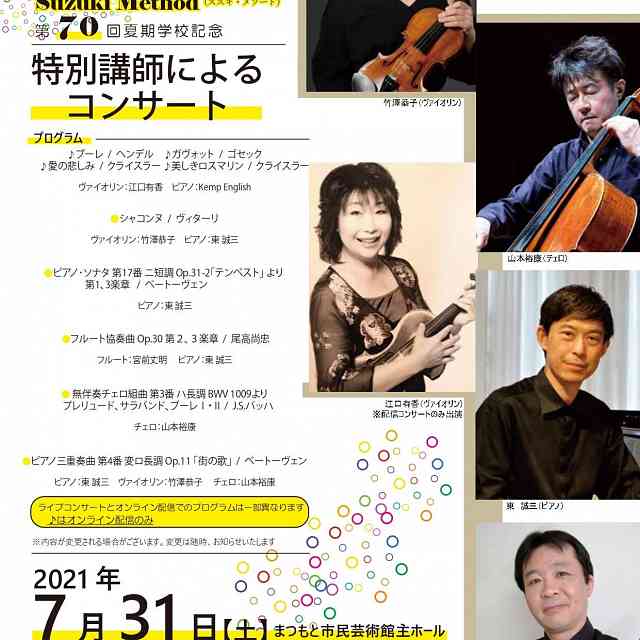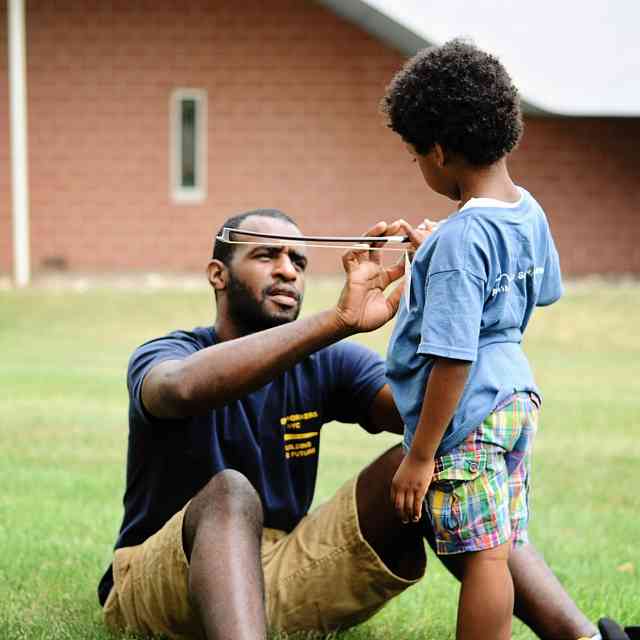
“Man is the son of his environment.”—Dr. Suzuki
I recently watched a video of a Suzuki group performing repertoire in an outdoor concert. The group’s playing was polished, but what stole the entire show was a two-year-old little boy. He had a tiny violin tucked under his arm, and was enthusiastically “playing” along with the group. It didn’t bother him that he didn’t know the notes and bowings to every piece. He was simply thrilled to be playing the music he had listened to his entire life alongside his older brother and the students he had observed.
As a Suzuki violin teacher, I love starting younger siblings of students in my studio. These young students have been observing their siblings’ lessons and practice for years, they’ve attended concerts and institutes, the Suzuki recordings have been a soundtrack to their days and nights, and they can’t wait until it’s their turn to have their very own lessons. These little violinists like the one I observed at the concert are overwhelmingly eager. They are delightful to teach and progress smoothly because they’ve been watching and participating in Suzuki music their entire lives!
But as anyone with more than one child can tell you, adding a second (or more!) Suzuki sibling into the routine can be anything but smooth. As a mom to five young musicians ages six to 19, the question I’m asked most often is “How do you do it? How do you manage to balance out all the practice time with all the rest of the demands of life?” My role as a Suzuki parent has been one of the most rewarding and challenging parts of parenthood, and every time I’ve added in an extra Suzuki sibling, the joys and the difficulties multiply exponentially. While I’ve been a Suzuki parent for sixteen years, I haven’t yet found a magic answer to solve all of the practicing problems. I have, however, found a few ideas and practical suggestions that have helped me as I juggle everyday practice and lessons with multiple small children.
- Every child is different. Theodore Roosevelt said “Comparison is the thief of joy,” and nowhere is this more true than in music study. Even if they are in the same family studying the same instrument with the same teacher, each Suzuki student has their own path and trajectory. What your older child breezed through with ease might prove to be more difficult for your new student, and you will likely discover unexpected strengths and struggles with each of your children that surprise you as you all progress. Every child deserves to have their own Suzuki experience. This might be your second (or third, or seventh) time through the Suzuki repertoire with a child, but it’s a first for this child. They have grown up watching their siblings and parents practice and perform, and are likely thrilled to finally have it be their turn to have a lesson, have dedicated practice time with a parent, and make music! Remember how wondrous it is to be a brand new beginner, and share that excitement with them.
- Don’t forget the basics. When there’s more than one child in the family taking lessons, there’s also likely more than one recording to listen to, more than one group class to attend, more schedules to juggle, and more music to organize. Your younger Suzuki child still needs to listen to their recordings, attend group lessons, and have all the same wonderful experiences that add up to success. Did you have fun with practice games, dice, toys, or incentives when you first started? Your younger Suzuki student will find those same things magical. When I started my youngest son on violin when he was three years old, I struggled for months to establish a practice routine that enabled me to practice with all three of my boys every day. I finally decided that, like my kids, I too needed an incentive as the practicing parent. I hung up a 100 days chart in the practice room and gave myself a sticker for every day that I practiced with all three of them. By the time the 100 days chart was filled, I had established a new habit, and practicing with three children each day had become much more manageable.
- Make practicing a priority. The more children you have to practice with, the more time it takes, and the more protective you have to be of that time. With school, sports, family time, and other commitments, it’s very easy for practice time to disappear if you don’t plan for it and protect it. I practice with one child before school, one child right after the older siblings leave for school, and one child immediately after school. If I know we’re going to have a busy day and plan to adjust the practice routine, we don’t get knocked off track. If I have to shorten one day’s practice, I’ll start the next day right where we left off, so that we aren’t neglecting anything that we’ve been assigned.
- Consistency is key to success. Practicing with multiple children every day is hard enough when no one is stalling, resisting, or flopping on the floor when it’s their turn to practice. I have repeatedly found that the resistance lessens if I am consistent with practicing and follow a routine. If children know that practicing is going to happen daily, no matter what, the fights about whether or not they are going to practice all but disappear. There are other benefits to a family culture of consistent practice as well—when you add a second to the practicing mix, they will already expect and know that practicing happens every day!
- Don’t be afraid to adapt and change. Just as every child is different, every family has unique circumstances. Your family’s routine for music lessons and practice doesn’t have to be the same as your teacher’s, your friend’s, or anyone else’s in your studio. You, as a parent, can design and implement a routine that works for you and your children, and then adapt that routine as necessary. In my own house, I find that our practicing routine looks different every year as my children grow and our commitments change. You know your and your family’s needs better than anyone. While you can certainly look to others for inspiration and ideas, ultimately, you are responsible for ensuring the plan for accomplishing daily practice with your children works for you.
- Practicing comes first. In our house, practicing comes before playing with friends, practicing comes before screen time, and practicing comes before outings and activities. I’ve also found it helpful to restrict screen time and time with friends until everyone has finished practicing. Siblings having fun outside with friends or playing video games is a sure way to stir up resentment in the child who is practicing, and tearing a child away from a favorite movie or activity is almost guaranteeing a grumpy practice.
- Rotate the practicing order. I’ve found that if I’m practicing with my children one after the other, that it’s essential to rotate who practices first every day. The first child to practice often gets more time, and each child benefits from being able to work with a fresh practice parent. My children are always quick to pick up on things not being “fair” and rotating who starts practice every day heads off the “I don’t want to practice first!” argument before it begins.
- Be realistic about other activities. Learning a musical instrument well requires a large investment of time, money, and emotion. That investment increases exponentially with each child you have in music lessons. Being overcommitted to other extracurriculars, no matter how worthwhile each one is, has the potential to decrease the amount of time your family has to practice and increase frustration if your children are tired during your only possible practice time.
- Try family group class. While each child needs their own uninterrupted practice time, occasionally combining parts of practice can bring variety and joy. Can you practice bow exercises together? Can an older sibling learn a duet to play with the younger sibling? Are there review games they can play together? Last Halloween morning, my three boys were all in costume, bouncing off the walls. I knew practicing still needed to happen, and that a “regular” practice would be an exercise in frustration. Instead, I called the three of them together, played 20-30 minutes of review pieces (in costume!), and called the practice a success. There are so many valuable lessons that can be learned as siblings make music together.
- Try morning practice. It might feel impossible to squeeze one more thing into your morning routine, but when there are multiple practice sessions to juggle, getting all or part of the practicing accomplished in the morning is an enormous help. Most children are less resistant and more responsive in the mornings, meaning you can get more accomplished in less time. Can you get up a few minutes earlier? Can one child get ready with the help of a checklist while you’re practicing with the other? It may take some juggling, rearranging, or adapting, but the amount you and your children can accomplish in the morning makes this a golden time that shouldn’t be missed.
- Work toward independence. With the blessing of your teacher, start identifying parts of practice, however small, that your students can be in charge of completing on their own. A specific assignment with instructions might give you time to distract a crazy two-year-old, help your first grader with a math problem, or take a few sips of coffee and breathe without worrying that practice will be completely derailed. I’ve found that my children can complete one or two simple assignments on their own at eight or nine years old, and you and your teacher can gradually increase those assignments as you work toward their complete independence in practicing. If your students are mature enough, they could even be practicing simultaneously in different rooms and you could float back and forth between them as needed.
- Use your village! When you’re trying to practice with and motivate a family full of musicians, you need all the help you can get! If you’re able to, make sure group lessons, recitals, rehearsals, weekend workshops, and institutes are an integral part of your music study for all your children. The motivation that comes from these events cannot be overstated. Do you have a music friend that you could invite over for a combined practice and play date for one of your children? Is there an older, more advanced student in your studio or music community that you could hire to mentor or practice with one of your children once or twice a week? Growing your music community will give your children a group of peers and friends to help them keep motivated. And having friends you can share Suzuki struggles and milestones with will help you keep your sanity as a practicing parent. Ask your teacher for help making connections for you and your students, or reach out to someone at your next group lesson or recital. There is such a sense of camaraderie and relief when you realize that there are others that are working, struggling, and succeeding at the same things you and your children are!
- Expect and learn to tolerate a certain level of chaos. When you are practicing with multiple children every day, the reality is that someone will likely be grumpy (sometimes it’s me!), someone will be distracted, someone will interrupt a sibling’s practice session, someone will have to itch the minute you get the instrument set up perfectly, someone will go to a lesson and act as if they haven’t practiced for a whole week, and there will be some days and weeks when you feel as if nothing is being accomplished. It’s all normal. My tendency as a parent is to wonder if every other parent-child duo has it all figured out and has perfect practices every day. After more than fifteen years of Suzuki teaching and parenting, I’ve found that we are all doing the best we can do. We love our kids, we are devoted to practicing and learning music, and some days will be better than others! Don’t beat yourself up if and when the practicing is chaotic—what you are doing takes time and effort to develop. It helps to remember that what we are doing is worth doing—even if it’s less than perfect, even if it’s messy and chaotic and feels as if you’re accomplishing very little from day to day. Remember this from Dr. Suzuki: “Never hurry, never rest.” It is through sustained, careful efforts that we will see progress.
One Friday afternoon a few years ago, all three of my boys had group lessons: three different groups, starting and ending at three different times in three different locations. It took careful planning and scheduling, several hours, and multiple drop-offs and pickups before we were finished for the day. On the way home, I was describing my afternoon logistics to someone who laughed and said “I sure hope all that craziness is worth it!” And as I listened to my boys in the back seat, chattering away about the repertoire they rehearsed that day, the games they played, and the music friends they connected with, I knew that every bit of it was worth it. I was grateful that we were able to spend an afternoon surrounded by dedicated students and parents as well as learning from teachers that were invested in nurturing and growing each child’s musical ability. I was grateful that each of my three boys had the opportunity to make friends and take part in a thriving musical community. I love that my youngest son counts down the days until group class every week and still talks about the teachers he worked with at an institute two summers ago, and I love that my cellist tells me that “Cello is still sometimes hard, but I’m glad I’ve kept going, even when I want to quit.”
There’s no doubt that the journey from being a young, eager beginner begging for lessons and dancing at concerts, to a mature, capable musician can seem daunting. The daily practicing can feel endless at times, the progress slow, and the logistics of managing many young musicians in a family overwhelming. But the payoffs, when they come, (and they will come!), are sweet. When you see your children play a duet for the first time, when one congratulates the other on a beautiful performance, when your family is surrounded by a nurturing, encouraging music community, and when you see your second Suzuki sibling grin with pride when they’ve mastered their first Twinkle Variation, you’ll know that all the effort was worth it.









